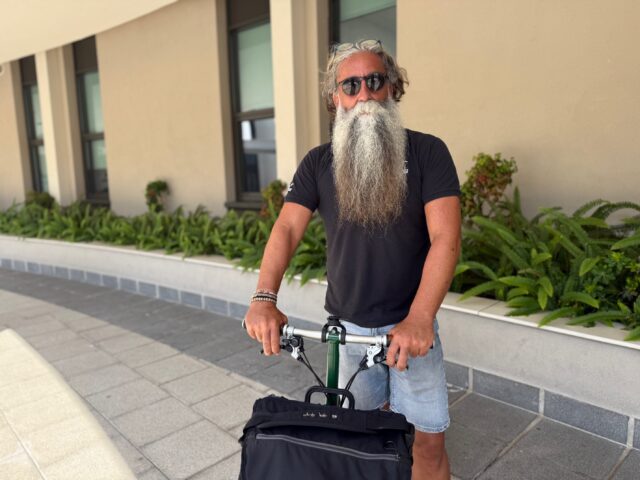As La Bateria ‘shared space’ triggers renewed debate on cycling infrastructure, Balban asks: ‘Do we want a car city, or a people city?’
Photo by Johnny Bugeja
The recent announcement that La Bateria had been officially designated as a shared space for pedestrians and cyclists once again triggered renewed discussion on the direction of sustainable transport planning on the Rock.
For some, the designation adds risk for pedestrians, even though the route has long been used by many cyclists especially children.
For others, it indicates a lack of depth in planning cycling infrastructure and a failure to understand cyclists’ needs.

Former Minister for Transport Paul Balban, who drove the project of to create cycling lanes during his time in office, welcomed the efforts of his successor, Dr John Cortes, but raised questions about the effectiveness of the scheme on the Saluting Battery, as the area is formally named.
Mr Balban, now ‘Bicycle Mayor of Gibraltar’, said the space “leads nowhere” and will require cyclists to dismount and walk at certain points, limiting its usefulness for commuters.
“Cyclists, especially commuters, want to get to work as quickly as possible. That’s why they use their bicycle for transport,” he said.
The area has been used informally by both cyclists and pedestrians for years.
But its formalisation has reignited discussion around sustainable transport options in Gibraltar.
“It’s been an area which has been shared for many, many years,” said Mr Balban.
“That’s where many people actually learn how to cycle, and many people use it on a daily basis to get to work.”
Acknowledging public criticism since the announcement, he said: “Every time you do something, there’s backlash.”
“All merit to Dr John Cortes, who at least is thinking [about sustainable transport],” he added.
“[But] he needs to have the support. He needs to have the funding. He needs also, again, people advising him… but it’s good to see that he is thinking in terms of cycling, because it’s been almost two years since the last election, and I’ve seen there’s been very little progress in terms of infrastructure.”
Mr Balban said what was need was a connected network for cyclists, rather than isolated segments of infrastructure.
“You don’t want to create little bridges here and there which are not connected, because people aren’t going to cycle into these little areas for no reason at all,” he said.
He also highlighted the importance of involving transport planners and engineers who cycle themselves.
“A cyclist sees things differently,” he said.
“Any cyclist probably knows more than an engineer or a planner when it comes to convenience and logic as to what a cycle lane or shared space should look like.”
Mr Balban commended Dr Cortes for learning how to cycle, adding: “He has also tried to become a cyclist. He still needs a lot more hours on the road, but he will start seeing things differently.”
He stressed too the wider public health and environmental benefits of cycling.
“It’s about fitness. It’s about health, public health, because behind all this is obesity, diabetes, heart disease. Because people are less active, their weights are higher, they’re overweight,” he said.
Looking ahead, Mr Balban said Gibraltar needs to decide what kind of city it wants to be.
“The most important thing is, what do we want for our city? Do we want a car city? Or do we want a people city?” he said.
“I will support any parliament that is pro-cyclists and pro-people, in respect of reinforcing the green city, the 15-minute city, the life we want to live.”
“If you want a car city, build more car parks. You get cars parking on pavements as they wait for the kids from out of school, and the police turn a blind eye. Then they see kids cycling on pavements, they tell them off. Cars are allowed to park on pavements, but kids aren't allowed to cycle on pavements.”
He said children and visitors often cycle on pavements because they do not feel safe on the roads.
And while he acknowledged that “some kids are nuisance”, he said “you can't generalise”.
Mr Balban also advocated for more user-friendly public spaces, with buildings designed to cantilever over pavements, such as on Devil’s Tower Road, allowing for cycle lanes and wider pavements.
This, he said, would also create space for planters, benches and even stalls, helping to “bring life back to the street.”
What is a Bicycle Mayor by the Bicycle Mayor Network (BYCS)?
The network was founded in 2016 when the first Bicycle Mayor was elected in Amsterdam. By 2020, the network had reached 100 Bicycle Mayors worldwide and in 2021 the BYCS India Foundation was established.
The role of a Bicycle Mayor in cities is to work to solve core issues and challenges related to cycling, collaborating with residents, activists, Government, MP’s and industry.
Within the network itself practices and experiences are shared.
The BYCS Network promotes the bicycle as a solution to some of the most complex urban challenges, keeping issues front and centre and moving forward through global and regional calls for action.









